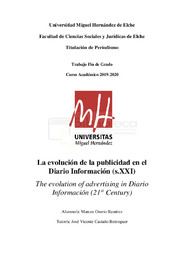Please use this identifier to cite or link to this item:
https://hdl.handle.net/11000/27216La evolución de la publicidad en el Diario Información (s.XXI)
| Title: La evolución de la publicidad en el Diario Información (s.XXI) |
| Authors: Osorio Ramírez, Marcos |
| Tutor: Castaño Berenguer, José Vicente |
| Editor: Universidad Miguel Hernández de Elche |
| Department: Departamentos de la UMH::Ciencias Sociales y Humanas |
| Issue Date: 2020-06-15 |
| URI: http://hdl.handle.net/11000/27216 |
| Abstract: "El periodismo es el mejor oficio del mundo”, decía Gabriel García Márquez, pero ¿qué pensaría ahora Gabo si viese que, eso que tanto amaba, se ha transformado a un ritmo vertiginoso en una máquina de negocios completamente diferente? Y es que, a decir verdad, tanto la forma de hacer periodismo como el periodismo propiamente dicho, ya sea por factores económicos como tecnológicos y sociales, han sufrido diversas transformaciones (Peiró, 2018). Porque con la llegada de la tecnología, muchos han optado por otras vertientes del periodismo, como el marketing digital, abandonando así el modo clásico de hacer periodismo, pero ese no es el quid de la cuestión: el problema se da cuando tanto la prensa tradicional como la esencia periodística se ven obligadas a cambiar, principalmente, debido a la crisis (Reig, 2015). Por ello, este trabajo estudia la evolución que ha sufrido la publicidad - tradicionalmente, el primer sustento económico de los periódicos- (J. Valera, 2018) en el Diario Información de Alicante a lo largo del siglo XXI. Con este objetivo en mente, los resultados han sido muy claros: el número de páginas en el periódico es cada vez menor, así como la cantidad de anuncios. A su vez, los anuncios de color van sustituyendo a la tradicional propaganda en blanco y negro y, por último, el periódico acaba publicitando principalmente artículos de autopromoción con ofertas de cartilla. Para la realización de este proyecto se ha empleado un análisis principalmente cuantitativo, pues gran parte del trabajo ha consistido en extraer los datos de los periódicos uno a uno y clasificándolos en una base de datos, organizándolos ahí atendiendo a varios factores. No obstante, también se emplea el análisis cualitativo: se busca comprender cómo la crisis ha afectado no solo al periodismo en general, sino concretamente en este medio. Asimismo, se completa este estudio con la realización de una entrevista a uno de los profesionales más cualificados para hacerlo: Juan Ramón Gil, Director General de Contenidos y exdirector en el Diario Información, que ha vivido la crisis de primera mano. ‘Journalism is the best job in the world’, said Gabriel García Márquez, but what would Gabo think now if he saw that, what he loved so much, has transformed at a dizzying pace into a completely different business machine? And, to tell the truth, both the way of doing journalism and journalism itself, whether due to economic, technological or social factors, have undergone various transformations (Peiró, 2018). Because with the arrival of technology, many have opted for other aspects of journalism, such as digital marketing, thus abandoning the classic way of doing journalism, but that is not the crux of the matter: the problem occurs when both the traditional press as the journalistic essence they are forced to change, mainly due to the crisis (Reig, 2015). For this reason, this work studies the evolution that advertising has undergone - traditionally, the first economic support of newspapers- (J. Valera, 2018) in the Diario Información de Alicante throughout the 21st century. With this goal in mind, the results have been very clear: the number of pages in the newspaper is decreasing, as well as the number of ads. In turn, the color advertisements are replacing the traditional black and white propaganda and, finally, the newspaper ends up mainly advertising self-promotion articles with booklet offers. To carry out this project, a mainly quantitative analysis has been used, since much of the work has consisted of extracting the data from the newspapers one by one and classifying them in a database, organizing them there according to various factors. However, qualitative analysis is also used: it seeks to understand how the crisis has affected not only journalism in general, but specifically in this medium. Likewise, this study is completed with the completion of an interview with one of the most qualified professionals to do so: Juan Ramón Gil, General Director of Contents and former director of Diario Información, who has experienced the crisis firsthand. |
| Keywords/Subjects: periodismo publicidad evolución Diario Información Alicante journalism ads evolution |
| Knowledge area: CDU: Generalidades.: Periódicos. Prensa. Periodismo. Ciencias de la información |
| Type of document: application/pdf |
| Access rights: info:eu-repo/semantics/openAccess |
| Appears in Collections: TFG- Periodismo |
.png)

